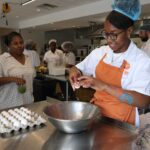
Growing up in Dorchester, Maria Lyons said she had limited access to nature. Her family went to the handful of small beaches in the area, spent time at the Franklin Park Zoo and public parks, but had few options beyond that. Then work to extend the Neponset River Greenway opened up a whole new resource.
A new photo exhibit at the New England Aquarium is working to bring attention to the Greenway, as well as the other areas where diverse Boston residents can access the water as part of an initiative to make the city’s waterfront more resilient and inclusive.
The exhibit, “Voices of the Waterfront,” was organized by the Aquarium in partnership with the Coalition for a Resilient and Inclusive Waterfront (CRIW), of which the Aquarium is a founding member.
Luz Arregoces, the Aquarium’s director of community engagement, said the exhibit is designed to showcase how people across the metro Boston area use its water resources and provide more art along the waterfront.
“The exhibit is meant to really bring joy to people as they walk around the harbor, walk in the Aquarium and show how people are engaging with their waterfront already,” said Arregoces, who helped organize the show. “My hope is that it spurs ideas and collaboration on what more we can do with our waterfront and along with that, how we can protect it.”
Lyons, now a member of the Neponset River Greenway Council — a group that promotes the 13-mile trail that, over a still-ongoing, 25-year-long project, opened up space along the river — said that showcase is especially important for areas like the Greenway, a multipurpose trail that cuts from where the river meets the shoreline in toward the Blue Hills Reservation. The Greenway Council is also a member of CRIW.
“The ‘Voices of the Waterfront’ is a great way to bring attention to all the neighborhoods waterfront that people might not know about and that would be much more easily accessible to them, as opposed to getting downtown,” Lyons said.
That focus on the city’s water resources more generally, not just on the shoreline, was key to the photo project, Arregoces said. Markings on each photo indicate where it was taken and in what part of the area’s water system — divided into the Neponset, Charles River, Mystic River or Boston Harbor.
Lyons said the focus on the four bodies of water will help bring greater attention and awareness to all the places Boston residents can interact with the region’s waterways, particularly ones that might be more easily accessible.
“Waterfront doesn’t have to be just downtown, it can be over in East Boston, it can be along the Mystic, it can be the Neponset,” Lyons said. “There’s a lot of places where there’s access to the water, and it might be a lot easier for people to get on the (Greenway) trail and come along the trail and access the water than try to get downtown and down to the Seaport or whatnot.”
Andres Ripley, Greenway’s program director at Neponset River Watershed Association, said equitable access to waterfronts across the city is important to making sure they are inclusive.
“When it comes to that inclusive waterfront mentality and that just those discussions, it’s important that everyone is having equal access to the waterfront, especially in their own community,” Ripley said. “That’s why I think the Neponset is so important, because you have so many environmental justice communities who live along the Neponset or live along the Greenway, a lot of communities of color, and it’s important that these folks get that same equal access to the waterfront that other folks have across the city.”
For Arregoces, the exhibit offers a chance to bring more people to the table to work on resilience efforts and to engage with members of CRIW.
“The hope is that this is just one example, and that it spurs people to want to look more into the shared mission between the Aquarium and the coalition and learn more about all the different partners,” Arregoces said.
It also stems from work the Aquarium has been doing to better understand how to develop a more inclusive downtown waterfront. Arregoces said a desire for more free, public art has been a refrain in listening sessions the Aquarium has been holding in Dorchester and East Boston since March.
Last year, the Aquarium held similar listening sessions in Mattapan, Hyde Park and Chinatown, and heard feedback about struggles with transportation to the waterfront as well as cost and inclusive programing.
The exhibit, which is to remain outside the Aquarium until spring of 2024, has already helped Arregoces, who lives near the Neponset River Greenway, learn more about her own community.
“I live actually near that trail, and I had never thought of it as a place that I could go to,” she said. “I helped create the exhibit and I’m learning something new like, ‘Oh, I should go for a bike ride or walk there.’”






